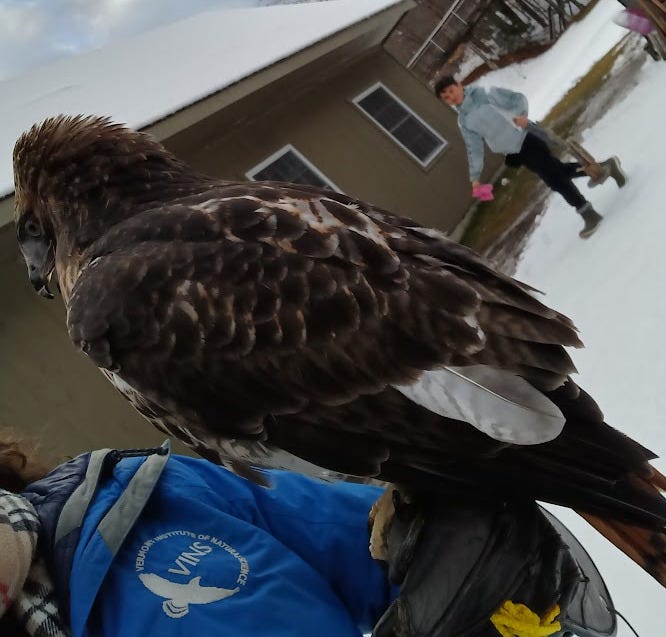Bird of Prey FAQs & Elaborate Answers - #3
How long will that bird live? and Why doesn't the bird bite you in the face with its beak?
How long will that bird live?
Longevity in raptors varies depending on species, and in general along an axis of size. The larger the bird, the longer the lifespan. The oldest known wild-living Golden Eagle was more than 31 years old; the oldest American Kestrel, only 14.
Another important component of lifespan is whether the bird lived most of its life in the wild or in human care. In some species, captive lifespans are shorter than those experienced by the same species in the wild. Reptiles are a great example of this: pet turtles, tortoises, lizards, and snakes tend not to live as long in captivity as they would in the wild, and we can mostly chalk that up to the fact that few people who keep reptile as pets are actually thoroughly informed, responsible reptile keepers, and fail to supply their charges with the proper, delicate balance of heat, light, and humidity. Reptiles in the wild evolved over sometimes hundreds of millions of years to take care of themselves in their particular habitat perfectly well, thank you. It’s when we humans come along and challenge them to live in less-than-ideal conditions that they fair worse.

But with raptors at least, it’s the opposite. With good, dedicated, knowledgeable care, most raptors species will live longer in human care than they will in the wild.
There are couple of reasons for this, the first being that in a human-care setting, birds are protected from most of the things that would stop them in the wild—starvation, predation, and traumatic injury. A bird in an enclosure that is fed a nutritious meal every day is just not going to get hit by a car, fly into a window, or get tangled in a soccer net. Secondly, birds living in the wild have higher mortality rates among the younger members of the species. This is due to the fact that “teenage” birds—newly fledged young trying to live independently from their parents for the first time—make a lot of dangerous mistakes, or may not have the capacity to survive the sparse winter season. Something like 80% of young Red-tailed Hawks don’t live to see their first birthday, thus pulling down the “average” reported lifespan for the species.
A handful of Red-tailed Hawks will survive those first few tough years, though, and live out closer to their full potential lifespan of 30 or so years. But, there are still ways in which human care can extend that. Birds are susceptible to some of the same diseases of old age as we are, including arthritis and cataracts. Not being able to see prey as well as you once could, or move swiftly to catch it, shortens one’s lifespan at that point as well. In human care, hunting is not crucial for sustenance, and we can provide accommodations that make dealing with the occasional, mild aches and pains a little easier.
Why doesn’t the bird bite you in the face with its beak?
First of all, rude. Are you implying I’ve done something to deserve losing a chunk of my flesh to this predatory bird? I mean, I probably have at some point or another done something that may have provoked them into lashing out at me, but we’re presently past that and no thank you very much for bringing it up again.
Two things about this one, though: the bird is neither inclined to harm me, nor to use its beak to do so.
The beak of a raptor is a sharp, hooked, tearing tool, for opening the hide of a freshly killed prey item and ripping meaty bits from bone. Some are sharper than others—vultures, for example, have can-opener like beaks and powerful neck muscles to rip into dried, leathery deer carcasses that have been bloating on the side of the road for a day or so. Owls generally swallow their prey whole, so their beak is less sharp—just less, though, not dull.
All this is to say that the beak of the raptor is not an offensive weapon, and for very good reason. Raptors are visual creatures like us and rely on their flawless eyesight to spot prey, predators, and navigate their world. Should a raptor be scooping up squirrels or snakes or fish face-first, they would risk damaging their precious eyes. Thus, a raptor’s main prey-capture and dispute-settling weapons are placed as far from the face as possible—in the talons. If the bird on my glove wanted to show me how it really felt about my restraining her for the veterinarian last month, she would likely “throw a foot”, or grab me with her talons.
But just as you and I have body language, social convention, or at the very least a general apathy toward one another, the bird on my glove has no inclination to “bite me in the face” any more than you (probably) have no inclination to come up and sock me. We are simply existing together, hopefully having established a positive relationship, and as I have not done anything to provoke you (I hope), said fist will not be coming my way.
Now, this doesn’t mean I haven’t been bitten in the face, or footed, or wing-slapped by a bird of prey. I have been footed because I was slow to present food, or being annoying and fiddly with tangled jesses, or just incautious when a Harris’s Hawk was already frustrated. But the fault is always my own, and these incidents would never have happened if I wasn’t dimly ignoring a bird who was trying to tell me to back off.

If you love what you read, let me know by dropping by my Ko-fi page:



Another entertaining and informative entry!
I love how the essay form really works for this, “ Questions Answered,” series, Anna. Thank you.